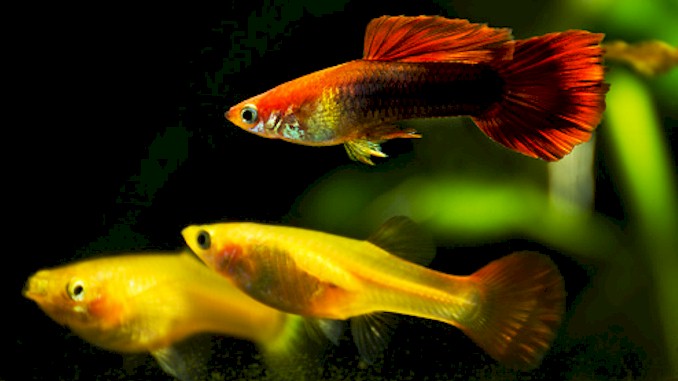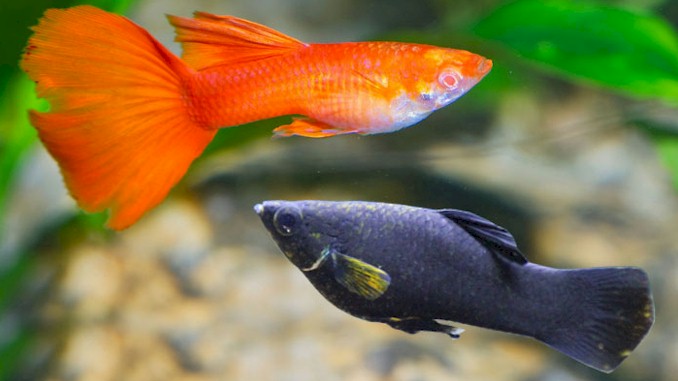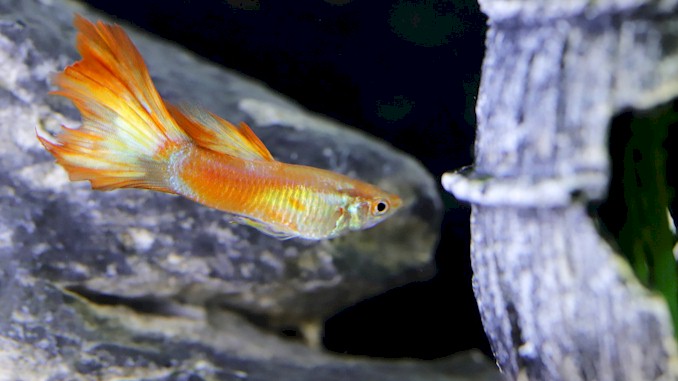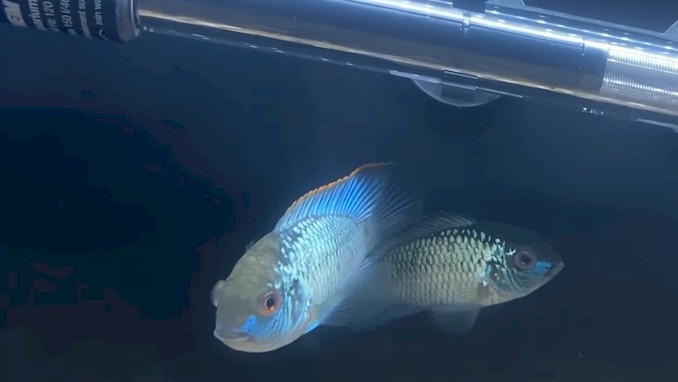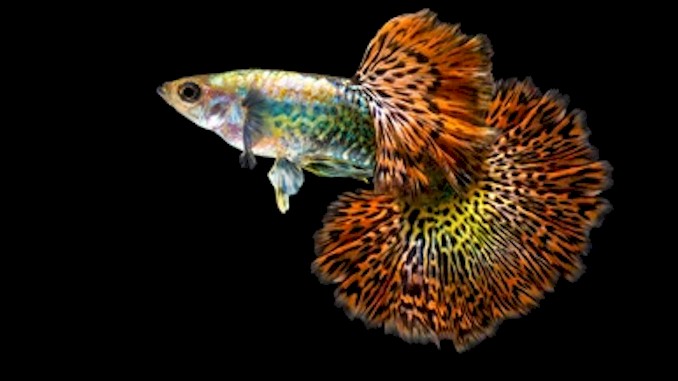How do Guppies Mate – A Complete Guide
If you are curious about how guppies mate, you have come to the right place. In this blog post, I will explain the process and the ideal conditions for guppy breeding. Guppies are one of the most popular and easy-to-keep aquarium fish, but they also have a fascinating and complex mating behavior. Whether you want to breed guppies for fun, for profit, or for research, you need to understand how they mate and what factors affect their reproduction. I have been keeping and breeding guppies for over 10 years, and I have learned a lot from my own experience and from reading scientific studies. In this post, I will share with you some of the secrets of guppy mating that will help you succeed in your breeding goals.
Guppies mate through internal fertilization, with the male transferring sperm to the female using a modified anal fin called a gonopodium. During courtship, males perform elaborate displays to attract females, including colorful body patterns and movements. After mating, the female can store sperm for several months and give birth to live young, with each clutch typically containing between 20-50 fry. Guppy mating behavior is influenced by various factors, including water temperature, light levels, and the presence of predators.
If you are fascinated by the mating behavior of guppies and want to learn more about this fascinating fish species, you have come to the right place. In the following paragraphs, I will delve deeper into the different stages of guppy mating, explain the role of male and female guppies in the mating process, and explore the fascinating ways that environmental factors can impact guppy reproduction. By the end of this post, you will have a comprehensive understanding of guppy mating behavior and be equipped with the knowledge to care for these amazing fish. So, let’s dive in!
Internal Fertilization: The Fascinating Mating Process of Guppies
Guppies are an incredibly fascinating fish species, and one of the most interesting aspects of their behavior is their mating process. Unlike some fish species, guppies reproduce through internal fertilization, with the male transferring sperm to the female using a specialized fin called a gonopodium.
The gonopodium is a modified anal fin that has evolved specifically for the purpose of mating. During courtship, the male guppy will approach the female and display his gonopodium, which he will then use to transfer his sperm to the female’s body. Once the sperm is inside the female’s body, it fertilizes the eggs, which then develop into live young.
The process of internal fertilization is incredibly efficient and ensures a high rate of fertilization, with the female typically giving birth to large clutches of live young. However, it also requires a certain level of coordination and timing between the male and female guppies. The male must be able to properly display his gonopodium and transfer the sperm at the right time, while the female must be receptive to the male’s advances and be able to store the sperm until it is needed.
As you can see, the process of internal fertilization in guppies is a complex and fascinating aspect of their behavior. It is just one of the many ways that these amazing fish have evolved to thrive in their environment, and it is a testament to the incredible diversity and adaptability of the natural world.
The Role of Courtship Displays in Guppy Mating Behavior
Courtship displays play a crucial role in guppy mating behavior. Male guppies use a variety of displays to attract female mates and convince them to mate. These displays can be visual, auditory, or even chemical, and they often involve bright colors, intricate patterns, and elaborate movements.
One of the most common courtship displays in guppies is the “tail wag” display. Male guppies will wag their tails back and forth, displaying their brightly colored caudal fins to female mates. This display is thought to be a way of showcasing the male’s genetic quality and overall health, as well as his ability to evade predators and survive in the wild.
Another important courtship display in guppies is the “zig-zag” display. Male guppies will swim back and forth in front of female mates, zig-zagging their bodies and flashing their fins in a rapid and complex display. This display is thought to be a way of showing off the male’s agility and strength, as well as his ability to protect the female and her offspring from predators.
In addition to these visual displays, male guppies may also use auditory displays to attract female mates. Male guppies have been shown to produce “chirping” sounds by rubbing their fins together, and these sounds have been shown to attract females from a distance.
Finally, male guppies may also use chemical displays to attract mates. Male guppies produce a pheromone called androstenone, which has been shown to increase female mate choice and reproductive success. Female guppies are able to detect androstenone in the water and may be more likely to mate with males that produce high levels of the pheromone.
Overall, courtship displays are a critical component of guppy mating behavior. These displays allow males to attract high-quality female mates and increase their reproductive success. They are also an important example of the incredible diversity and complexity of animal behavior, and a fascinating area of study for researchers and fish enthusiasts alike.
Storing Sperm and Giving Birth: Understanding the Reproductive Process of Guppies
The reproductive process of guppies involves a unique combination of internal fertilization, sperm storage, and live birth. After mating, the female guppy is able to store sperm in her body for several months, allowing her to fertilize multiple clutches of eggs without the need for multiple matings.
The ability to store sperm is an important adaptation for guppies, as it allows females to maximize their reproductive success and ensure that they can continue to produce offspring even if a suitable mate is not available. However, it also requires a certain level of coordination between the male and female guppies, as the male must be able to transfer enough sperm to the female to ensure fertilization, while the female must be able to store the sperm and use it to fertilize multiple clutches of eggs over time.
Once the eggs are fertilized, they develop inside the female’s body until they are ready to be born. Guppies are unique in that they give birth to live young, rather than laying eggs like many other fish species. This adaptation allows guppy offspring to be more developed and better able to survive in their environment, as they are able to immediately swim and feed on their own after birth.
The process of giving birth in guppies is relatively quick and straightforward, with the female typically releasing a clutch of live young in a matter of minutes. However, the size of the clutch can vary greatly depending on a number of factors, including the size and health of the female, the quality of the sperm used for fertilization, and the environmental conditions in which the offspring will be raised.
Now you have learned, the reproductive process of guppies is a fascinating and complex topic that highlights the incredible diversity and adaptability of the natural world. By understanding the unique adaptations and behaviors of these amazing fish, we can gain a greater appreciation for the complexity and beauty of the world around us.
How Environmental Factors Influence Guppy Reproduction
The reproductive success of guppies is influenced by a variety of environmental factors, including water temperature, pH, and nutrient levels. These factors can have a significant impact on the health and behavior of guppies, which in turn can affect their ability to mate and produce offspring.
One key environmental factor that affects guppy reproduction is water temperature. Guppies are tropical fish that thrive in warm water environments, and research has shown that water temperature can significantly impact their reproductive success. For example, studies have shown that guppies kept in water that is too cold or too warm may have reduced fertility rates, and may also experience changes in their courtship behavior and mating preferences.
Another important environmental factor that influences guppy reproduction is water chemistry. Guppies are sensitive to changes in water pH and nutrient levels, and exposure to high levels of toxins or pollutants can have a detrimental effect on their reproductive health. For example, studies have shown that exposure to high levels of heavy metals or other pollutants can lead to reduced fertility rates and increased mortality in guppies.
In addition to water temperature and chemistry, other environmental factors such as predator presence and habitat quality can also impact guppy reproduction. For example, guppies that live in environments with high predator densities may have reduced reproductive success due to increased stress levels and decreased mating opportunities. Similarly, guppies that live in habitats with low food availability or poor water quality may experience reduced reproductive success due to increased competition and decreased overall health.
As you know, understanding the complex interplay between environmental factors and guppy reproduction is a critical step in protecting these amazing fish and ensuring their long-term survival. By studying the impact of environmental factors on guppy populations, we can gain valuable insights into the ways in which human activities and environmental changes are affecting the natural world, and work to develop strategies to protect and preserve these important species.
How often do guppies mate?
Guppies are known for their prolific breeding habits, and it’s not uncommon for females to give birth to dozens of fry in a single pregnancy. But just how often do guppies mate, and what factors influence their mating behavior?
In the wild, guppies typically mate several times per day, with males actively courting females and attempting to mate whenever possible. However, the frequency of mating can vary depending on a variety of factors, including water temperature, population density, and the availability of mates.
One key factor that influences the frequency of guppy mating is water temperature. Guppies are more active and more likely to mate in warm water environments, and research has shown that temperature fluctuations can impact their overall reproductive behavior. For example, guppies may mate less frequently in water that is too cold or too warm, as they are less active and less likely to engage in courtship behaviors.
Population density is another important factor that can impact the frequency of guppy mating. In environments with high population densities, guppies may have more mating opportunities but also face increased competition for mates. This can lead to complex mating dynamics, with males engaging in aggressive behaviors to secure mating opportunities and females being more selective in their choice of partners.
The availability of mates is also an important factor that influences the frequency of guppy mating. In environments with a high ratio of males to females, competition for mates can be intense, leading to more frequent mating behaviors. Conversely, in environments with a high ratio of females to males, males may have fewer opportunities to mate and may engage in more selective mating behaviors.
Now you know the frequency of guppy mating can vary widely depending on a variety of factors, and understanding the complex interplay between these factors is critical for understanding the reproductive behavior of these amazing fish. By studying the mating habits of guppies, we can gain valuable insights into the ways in which environmental factors influence the behavior and reproductive success of aquatic organisms, and work to develop strategies to protect and conserve these important species.
How long does it take for guppies to mate?
Guppies are known for their quick and efficient mating behavior, and the actual mating process itself typically only takes a few seconds. However, there are several factors that can influence the timing and duration of guppy mating, including courtship behavior, female receptiveness, and male mating success.
Courtship behavior is an important precursor to guppy mating, and males will engage in elaborate displays and behaviors to attract the attention of potential mates. This can include flaring their fins, displaying their bright colors, and engaging in chase behaviors to pursue and court females. These courtship behaviors can last anywhere from a few seconds to several minutes, and the duration and intensity of courtship can impact the likelihood of successful mating.
Once a male has successfully courted a female, the actual mating process itself is typically very quick, lasting only a few seconds. During mating, the male will use his gonopodium (a specialized reproductive organ) to transfer sperm to the female, who will store the sperm until she is ready to fertilize her eggs. This process typically only takes a few seconds, and males will often move on to mate with other females soon afterwards.
However, the timing and duration of guppy mating can also be influenced by female receptiveness and male mating success. Females may only be receptive to mating during certain periods of their reproductive cycle, and males may need to engage in multiple courtship attempts before successfully mating with a female. Additionally, in environments with high population densities, males may face increased competition for mates, leading to more intense courtship behaviors and longer mating durations.
That’s it. Now you know the duration of guppy mating can vary widely depending on a variety of factors, and understanding the factors that influence the timing and success of mating is critical for understanding the reproductive behavior of these fascinating fish. By studying the mating habits of guppies, we can gain valuable insights into the ways in which environmental factors influence the behavior and reproductive success of aquatic organisms and work to develop strategies to protect and conserve these important species.
What Happens After Guppies Mate
After guppies mate, the female will typically store the sperm in her body until she is ready to fertilize her eggs. This can occur immediately or be delayed for several days, depending on factors such as the female’s reproductive cycle and environmental conditions.
Once the female is ready to fertilize her eggs, she will use the stored sperm to fertilize them internally. Guppies are livebearers, which means that the female will carry her fertilized eggs (called embryos) inside her body until they are fully developed.
The gestation period for guppies can vary depending on a variety of factors, including water temperature, female age and size, and the number of embryos being carried. Typically, however, guppy gestation lasts for around 4-6 weeks.
During this time, the embryos will develop and grow inside the female’s body, feeding on the yolk sac attached to their bodies. Once the embryos are fully developed, the female will give birth to live, fully-formed fry (baby fish).
Guppies are known for their prolific breeding habits, and a single female can give birth to multiple broods of fry over the course of her lifetime. In fact, some female guppies are capable of storing sperm for several months, meaning that they can continue to give birth to new litters of fry without mating again.
As you know, the process of mating and giving birth is a critical aspect of guppy reproduction, and understanding the intricacies of this process is key to understanding the behavior and life cycle of these fascinating fish. By studying the reproductive habits of guppies, we can gain valuable insights into the ways in which environmental factors and other variables impact the success of aquatic organisms, and work to develop strategies to protect and conserve these important species.
How to Identify A Pregnant Guppy
Identifying a pregnant guppy is relatively easy if you know what to look for. As livebearers, female guppies carry their fertilized eggs (or embryos) inside their bodies until they are ready to give birth to fully-formed fry. Here are some key signs to look for when trying to identify a pregnant guppy:
- Increased Abdominal Size: One of the most obvious signs of a pregnant guppy is a noticeably larger abdomen. As the embryos develop and grow inside her body, the female’s belly will become visibly swollen and distended.
- Darker Coloration: Pregnant guppies often display darker and more vivid colors, particularly around the belly area. This is due to increased blood flow to the area, as well as changes in the pigmentation of the skin.
- Gravid Spot: The gravid spot is a dark spot that appears near the back of the female’s abdomen. This spot is actually a cluster of developing embryos visible through the skin of the female’s belly.
- Changes in Behavior: Pregnant guppies may display changes in behavior, such as increased hiding, reduced appetite, or a preference for hiding in the plants or other hiding spots in the aquarium.
- Elevated Position: Pregnant guppies often swim towards the surface of the water and position themselves in a more elevated position, as they may find it difficult to move around due to the added weight of the embryos in their belly.
By observing these signs, you can quickly and easily identify whether or not your female guppy is pregnant. Keep in mind that the gestation period for guppies can vary depending on a variety of factors, so be patient and keep a close eye on your female guppies to ensure that they receive the care and attention they need during this critical time.
How To Create Optimal Conditions For Guppy Gestation
Creating optimal conditions for guppy gestation is essential for the health and well-being of both the pregnant guppy and her developing fry. Here are some tips on how to create the best possible conditions for guppy gestation:
- Provide a Spacious Aquarium: Pregnant guppies need plenty of room to move around, so make sure to provide them with a spacious aquarium. A good rule of thumb is to have at least 10 gallons of water per adult guppy.
- Maintain Stable Water Parameters: Guppies are sensitive to changes in water chemistry, so it’s important to maintain stable water parameters throughout the gestation period. Keep the water temperature between 75 and 82°F, pH between 7.0 and 8.5, and ammonia and nitrite levels at 0 ppm.
- Keep the Aquarium Clean: Clean water is essential for the health of pregnant guppies and their fry. Perform regular water changes of 20-30% every week and keep the substrate and decorations clean.
- Provide Plenty of Hiding Places: Pregnant guppies may become stressed and agitated if they don’t have a place to hide. Provide plenty of hiding places such as plants, rocks, and caves.
- Feed Nutritious Food: Pregnant guppies require a balanced and nutritious diet to support the growth and development of their fry. Feed them a variety of high-quality foods such as flakes, pellets, and frozen or live foods.
- Avoid Stressful Situations: Pregnant guppies can be sensitive to stress, so avoid any situations that may cause them undue stress such as sudden changes in water parameters, overcrowding, or aggressive tankmates.
By following these tips, you can create optimal conditions for guppy gestation, which will help ensure the health and well-being of your pregnant guppies and their developing fry. Remember to monitor your aquarium regularly and make any necessary adjustments to the water parameters or environment to ensure that your guppies are happy and healthy.
How to Care for Guppy Fry?


Caring for guppy fry can be a rewarding experience, but it requires a bit of knowledge and preparation. In this section, we will discuss how to care for guppy fry and give them the best chance of survival.
- Separating the Fry: The first step in caring for guppy fry is to separate them from adult guppies. Adult guppies may eat their fry, so it is important to move the fry to a separate tank as soon as possible.
- Feeding the Fry: Guppy fry are tiny and require small, frequent feedings. Infusoria, baby brine shrimp, and powdered fry food are all good options for feeding guppy fry. It is important not to overfeed the fry, as this can cause water quality problems.
- Maintaining Water Quality: Guppy fry are sensitive to changes in water quality, so it is essential to keep their tank clean and well-maintained. A filter and regular water changes can help ensure good water quality.
- Providing Hiding Places: Guppy fry need places to hide to feel secure and avoid being eaten by adult fish. Plants, rocks, and other decorations can provide shelter for the fry.
- Monitoring Growth and Health: Regular monitoring of the fry’s growth and health can help you identify any problems early on. Watch for signs of illness, such as lethargy, loss of appetite, or abnormal behavior, and take action if necessary.
By following these tips, you can successfully care for guppy fry and enjoy watching them grow into healthy adult fish.
You can check out my article on how to care for guppy fry by clicking this link.
Related Questions:
Will guppies breed with other fish? No, guppies will not typically breed with other fish. Guppies are a species of live-bearing freshwater fish and can only breed with other guppies. However, if you have other live-bearing fish in your tank, such as mollies or platies, they may interbreed with guppies and produce hybrid offspring. It is generally recommended to keep different species of live-bearing fish in separate tanks to avoid interbreeding and preserve the purity of the species.
How many male and female guppies can live together in a tank? The ideal male to female ratio for guppies in a tank is about 1:2 to 1:3, meaning for every male guppy, there should be two to three female guppies. This helps to prevent male guppies from becoming too aggressive towards each other, as they can sometimes compete for mates. It also allows for a better breeding environment, as there are enough females to ensure that males do not constantly harass a single female. Keeping more females than males can also help prevent the females from becoming too stressed or overbred. As a general rule of thumb, a 10-gallon tank can accommodate up to 10-15 guppies.

